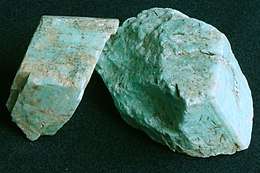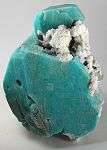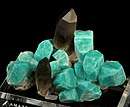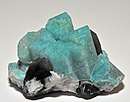Amazonite
| Amazonite | |
|---|---|
 Amazonite from Brazil | |
| General | |
| Category | Tectosilicate |
| Formula (repeating unit) | K(AlSi3O8) |
| Crystal system | Triclinic |
| Identification | |
| Color | Green, blue-green |
| Crystal habit | Prismatic |
| Cleavage | Perfect |
| Fracture | Uneven, splintery |
| Tenacity | Brittle |
| Mohs scale hardness | 6-6.5 |
| Luster | Vitreous |
| Streak | White |
| Diaphaneity | Translucent, opaque |
| Specific gravity | 2.56-2.58 |
| Refractive index | 1.522-1.530 |
| Birefringence | -0.008 |
| Pleochroism | Absent |
| Dispersion | None |
| Ultraviolet fluorescence | Weak; olive-green |
| References | [1] |
Amazonite also known as Amazonstone is a green tectosilicate mineral made from microcline.[2][3] It has the chemical formula K(AlSi3O8).[1][4]
Its name is taken from that of the Amazon River, from which certain green stones were formerly obtained, but it is doubtful whether green feldspar occurs in the Amazon area.[5]
Because of its bright green color when polished, amazonite is sometimes cut and used as a cheap gemstone, although it is easily fractured, and loses its gloss due to its softness.
Occurrence
Amazonite is a mineral of limited occurrence. Formerly it was obtained almost exclusively from the area of Miass in the Ilmensky Mountains, 50 miles southwest of Chelyabinsk, Russia, where it occurs in granitic rocks.[5] Amazonite also occurs in granitic rocks in Jabal Eghei in the Tibesti Mountains, Libya,[6] and in the Baishitouquan granite intrusion in Xinjiang, China.[7] More recently, high-quality crystals have been obtained from Pike's Peak, Colorado, where it is found associated with smoky quartz, orthoclase, and albite in a coarse granite or pegmatite.[5] Crystals of amazonite can also be found in Crystal Park, El Paso County, Colorado. Other locations in the United States which yield amazonite include the Morefield Mine in Amelia Courthouse, Virginia.[8]
Color
For many years, the source of amazonite's color was a mystery.[9] Some people assumed the color was due to copper because copper compounds often have blue and green colors.[9] A 1985 study suggest that the blue-green color results from small quantities of lead and water in the feldspar.[9]
Gallery
 Deep robins-egg blue color amazonite on smoky quartz
Deep robins-egg blue color amazonite on smoky quartz- Crystals of amazonite, from Pikes Peak, El Paso County, Colorado
 Large Amazonite crystal from Konso special woreda, Ethiopia. Size: 16.4 x 11.9 x 8.0 cm.
Large Amazonite crystal from Konso special woreda, Ethiopia. Size: 16.4 x 11.9 x 8.0 cm. Two smoky quartz crystals leaping out from surrounding amazonite
Two smoky quartz crystals leaping out from surrounding amazonite Amazonite crystals on feldspar
Amazonite crystals on feldspar Crystal of amazonite from the Take 5 claim near Florissant, Colorado (size: 4.4 x 4 x 3.5 cm)
Crystal of amazonite from the Take 5 claim near Florissant, Colorado (size: 4.4 x 4 x 3.5 cm)
References
- 1 2 Walter, Schumann (1997). Gemstones of the world (Rev. & expanded ed.). New York: Sterling Pub. Co. p. 164. ISBN 0806994614 – via Internet Archive.
- ↑ "Amazonstone". Encyclopedia Britannica. Retrieved 13 April 2017.
- ↑ "Amazonite gemstone information". gemdat.org. Retrieved 2018-08-24.
- ↑ "Amazonite: Amazonite mineral information and data". mindat.org. Retrieved 13 April 2017.
- 1 2 3

- ↑ Suayah, Ismail B.; Miller, Jonathan S.; Miller, Brent V.; et al. (April 2006). "Tectonic significance of Late Neoproterozoic granites from the Tibesti massif in southern Libya inferred from Sr and Nd isotopes and U–Pb zircon data" (PDF). Journal of African Earth Sciences. 44 (4–5): 564. doi:10.1016/j.jafrearsci.2005.11.020. ISSN 1464-343X – via Semantic Scholar.
- ↑ Yang, Jianye; Zhao, Lei; Zhang, Weiguo (April 2014). "The Geochemical Effect of Lanthanides: Its Types and Application for Magmatic Rocks—A New Method to Semi-Quantitatively Determine Strength of Magmatic Fluid Complexation and Fractional Crystallization" (PDF). Journal of Earth Science. 25 (2): 252–262. doi:10.1007/s12583-014-0420-z. ISSN 1674-487X.
- ↑ D. Allen Penick, Jr. and Palmer C. Sweet, Mineral Collecting Sites in Virginia, Virginia Minerals, May 1992, V. 38, No. 2, pp. 10–11 Archived 2012-04-24 at the Wayback Machine.
- 1 2 3 Hoffmeister and Rossman (1985). "A spectroscopic study of irradiation coloring of amazonite; structurally hydrous, Pb-bearing feldspar" (PDF). American Mineralogist. 70: 794–804 – via Mineralogical Society of America.
- Perl, Richard M. (1972). Colorado Gem Trails: And Mineral Guide. Swallow Press. ISBN 978-0-8040-0956-0.
| Wikimedia Commons has media related to Amazonite. |
